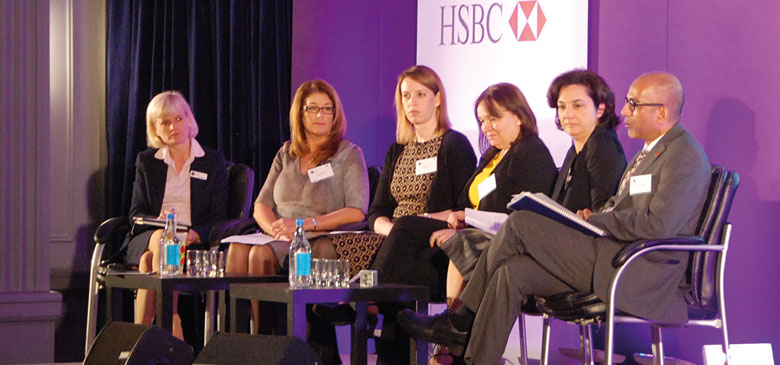
Disruption has turned out to be this year’s most distinctive feature, Michelle Price, associate director of the ACT’s policy and technical team, noted as she opened the ACT Treasury Forum on 9 November.
Like the rest of the world, the 150 treasurers gathered for the event were digesting the news of Donald Trump’s surprise victory in the US presidential election. Janet Henry, global chief economist at HSBC, which sponsored the event, was on hand to offer her insights.
Immediate reaction in financial markets had been surprisingly muted, she said, with sterling remarkably stable. But with the Mexican peso falling sharply and treasury yields rising, there was certainly a great deal of activity on the day of the results.
Cybercriminals often have an organisation’s reputation in their sights
“Trump clearly represents uncertainty,” Henry said. “We are talking about the election of someone who has spelt out a much more isolationist approach within the US economic and foreign policy. It does mean a much more uncertain outlook for the global economy.”
That protectionism was a cause for concern, she said. Trump’s campaign promises of lower taxes and increased infrastructure spending could support growth in the US economy in the short term.
But his dislike for international trade accords – North American Free Trade Agreement and the yet-to-be-signed Trans-Pacific Partnership – and his cited aim to impose import tariffs on China and Mexico of 45% and 35% respectively, suggest a less-than-positive picture for conditions longer term.
The Trump win also extends uncertainty to the picture for interest rates, Henry explained. “There has been a growing expectation that the [US Federal Reserve] is going to raise interest rates in December,” she said. “But if we see a lot of uncertainty in financial markets, that could even restrain the Fed and that could impact on the ability of emerging markets to ease rates themselves.”
Delegates chose between four discussion groups – investable cash, cyber risk and fraud, global cash management and regulatory reality – before reconvening to highlight the threats and opportunities they had identified within each session. The discussions took place under Chatham House Rules, enabling participants to share their views and experiences freely.
The issue of how to direct investable cash, a theme that Alan Thomas, HSBC’s co-head of UK banking, touched on in his welcome address (see 'The picture for banks', below), was explored in a session facilitated by ACT CEO Colin Tyler. Anne Coghlan, head of treasury at Weybourne Partners, and Jonathan Curry, Global CIO, HSBC Global Asset Management Liquidity, CIO of HSBC Global Asset Management USA, led the discussion.
The overall sentiment was that treasurers have a breadth of insight into this issue, which should enable them to conduct a full dialogue with their bank relationship managers.
In the audience’s view, the biggest opportunity for treasurers in this field was that possibility of full discussion with the board and wider business on how to get more out of excess cash. The next most significant opportunity lay in the enhanced profile for treasurers these discussions might bring. A third, smaller contingent identified the potential to be more tactical and take advantage of regulatory change.
The greatest threat, according to just over half of the audience, was the uncertainty around low yields. Around a third said the loss of products or market capacity was significant and a smaller contingent said further regulation was the biggest threat.
In a session led by James Lockyer, the ACT’s development director, participants heard how cyberattacks from organised criminal enterprises, industrial in scale, were increasing. Apart from the profit motive, cybercriminals or ‘hacktivists’ often have an organisation’s reputation in their sights. CEO frauds are a mounting concern, said one participant.
Nadya Hijazi, MD and global head of PCM and e-commerce at HSBC, explained that far from laying responsibility at the door of one particular function within corporates, regulators regard cybersecurity as everyone’s responsibility.
Treasury functions are prime targets within organisations and treasurers should not underestimate the willingness of cybercriminals to research corporates and even individual employees in great detail. Training and awareness needs to be inbuilt and frequent.
Corporates need to look at their people, processes and systems in a holistic way to build a uniform approach to cybersecurity, as weaknesses in any area can create a risk. In this respect, they should be conscious of not only their own systems, but also how those systems connect into the wider organisation and their associated controls.
Similarly, the end-to-end processes and their controls need to be understood, including processes around incident management and controls to ensure that master data records on beneficiary information are not updated on the back of emails or that any instruction to move large funds includes callbacks and other similar measures as well as regular scenario exercises.
Cyber insurance is relatively new, so sharing information makes all parties better informed. Next came ensuring your defences are better than other less vigilant organisations. Hackers will tend to attack the most obviously lax targets. Finally, participants identified centralisation – providing it is secure – as a good option.
People represented the greatest threat, according to an audience vote on the subject, particularly in relation to social media use, which opens doors to malware, as well as providing hackers personal information. Processes and hardware security were also a concern.
In a discussion conducted by Will Spinney, the ACT’s associate director of professional standards and learning; Julie Fabris, treasurer at Britax; Robin Terry, MD and head of corporate sales for Europe at HSBC; and Jennifer Doherty, global head of commercialisation, liquidity and investment solutions at the bank; participants heard how treasurers are likely to see continued focus on increasing efficiency, managing liquidity, centralisation and automation.
Regulation, liquidity and the EU payment services directive will continue to exercise the treasury community, while the practicalities of Brexit will clearly remain on the agenda for the next couple of years.
The quality of the interaction with banks on these issues was a persistent theme. While there can be frustrations around the bank-corporate relationship, treasurers need to be aware of the challenges banks face, particularly on the regulatory front.
That said, greater cooperation between banks, such as one digital solution for signature acceptance adopted across the sector, would solve myriad issues, said one participant.
Bankers in the panel confirmed that the industry was moving towards a more coordinated approach and that technological solutions to know-your-customer (KYC) issues, such as KYC.com, which streamlines new bank adoption by sharing documents across banks.
Streamlining KYC was identified as the biggest opportunity by audience members, followed by Brexit issues (from the corporate perspective) and greater take-up of virtual accounts. Ring-fencing was seen as the biggest threat in relation to UK cash management, followed by the implications of Brexit (from a treasury function perspective).
Steve Baseby, associate policy and technical director at the ACT, Jane Pilcher, group treasurer of Anglian Water, and James L Chew, group head of regulatory policy at HSBC, discussed the implications for corporate treasurers at the heart of measures, including Basel III, risk-weighted assets, the Vickers report and the Capital Markets Union.
The growth of the private placement market was regarded as the biggest opportunity by audience members, followed by the possible emergence of an intermediary to communicate regulatory issues to the non-financial community.
The biggest threats were seen as the possibility of ‘over-safe’ banks forcing non-financial corporates (NFCs) to hold still more cash. An equal number of voters saw the difficulties for NFCs in keeping track of regulation and regulators, and financial services failing to think through the impact of regulation on real economy businesses as the next most significant risk areas.
The forum, which preceded the ACT’s Annual Dinner, prompted wide-ranging discussion, with participants fully engaging with the issues.
In his welcome address, Alan Thomas, co-head of UK banking at HSBC, delved into those regulatory and market pressures that impact on the working partnership between banks and corporates.
The combined forces of challenges, such as KYC, along with the importance of protecting organisations from financial crime weigh heavily on today’s businesses, he said. Dealing with investable cash was of particular note.
“That is certainly a challenge in today’s world of low interest rates. The days of efficient balance sheets and minimising cash seem to have gone and many companies have billions in cash that they’re not getting any interest on,” he said.
On the banking side, compliance with Basel III has already prompted profound balance sheet change, Thomas said. “HSBC is reducing its risk-weighted assets (RWAs) by $190bn. This is a way of getting the bank’s balance sheet cleaner. The focus for banks is more about returns than it is pure numbers in RWAs. It’s about appropriate returns on relationships. It’s an old topic and one we work on together. This is something where banks are having to take hard decisions, much harder than previously,” he said.
Liz Loxton is editor of The Treasurer.
This article was taken from the Dec 2016/Jan 2017 issue of The Treasurer magazine. For more great insights, log in to view the full issue or sign up for eAffiliate membership
